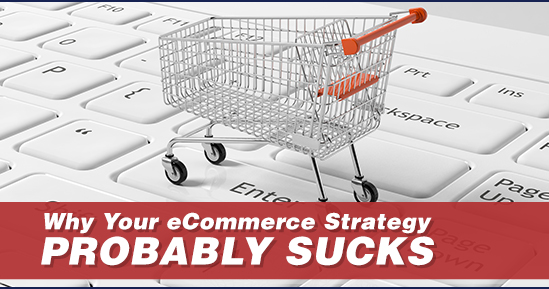
5 Reasons Why Your eCommerce Strategy Probably Sucks
So does your ecommerce strategy suck?
You may not be sure… but I probably have you second guessing yourself now.
To start off, I assume that most people would not say that your ecom strategy “sucks”.
As an 18 year P&G veteran, well trained in the art of being politically correct, I would use a more descriptive and less-negative sounding word. I would never have used the word “suck”… even if a huge vacuum sound was getting stronger and stronger.
So if you believe that your strategy is:
- not comprehensive,
- insufficient,
- not based on analysis, or
- not cross-functional in nature,
Then this article is for you.
If you are the person brave enough to say, “our ecommerce strategy sucks!”, well then good for you!
Let’s roll up our sleeves then and talk about your ecommerce strategy.
Realizing the Truth
The first step is admitting there is a problem!
It’s even better if you are ready to take action now.
No one wakes up and says, “I think I will create an ecommerce strategy that stinks.” In fact, most would not even think about a specific ecommerce strategy.
Just Waking Up…
Some companies are just waking up.
They are realizing that ecommerce may become the leading channel over time.
Even if dominance of the channel is not happening in the near future, the instantaneous nature and data trails it is starting to lead the direction in consumer understanding, pricing, promotion, advertising for a brand.
It’s Urgent to Put in Place a Comprehensive eCommerce Channel Strategy!
An ecommerce strategy that shines has many components. It addresses the key opportunities for growth, works to improve key issues, and is comprehensive in nature. It fits with traditional channel strategies, individual retailer strategies, and includes product supply and marketing components.
A brilliant ecommerce strategy supports measurable growth that is better than competition.
Companies And brands that have strong e-commerce strategies grow faster than competition
Top 5 Reasons Why Your Ecommerce Strategy Probably Sucks
I am going to count down the key reasons why an e-commerce strategy may be insufficient. The goal is that through recognition of the problem you can get over the hump
Issue #5: There is No e-Commerce Strategy
As scary as it sounds…
It’s estimated that over 80% of brands don’t have a specific ecommerce strategy. Many do have the throw-away “win with ecommerce” listed on the total business plan for the year.
They may even have a couple tactics thrown in for good measure… but really-really, this doesn’t count.
Saying, “we are going to grow with Amazon” isn’t a strategy or a tactic… it’s really what most companies will do to stay alive in today’s world.
So to be clear, you do not have an ecommerce strategy if you do not have stand-alone objectives, goals, strategy, tactics, and measures for the channel. These need to be well thought out and developed by a cross-functional management team.
Issue #4: Planning Follows a “More of the Same” Approach
Your ecommerce strategy is limp if you have decided to basically “do a little bit more” of what you did last year.
This is pretty common for those that don’t have an accountable ecommerce executive to put real thought into the process. It’s also common if you honestly believe that you will simply do what “the big A” asks.
As with most businesses, “cruise control” only works some of the time. Especially in a highly competitive and fast-moving market, you need to not just control, but guide the acceleration of business results.
Over the last year I have heard many of the same excuses for not having a strategy in place:
- “it’s taking time to get a team in place”,
- “we are just starting to recognize the channel growth”,
- “we are just thinking about adding a direct business”,
- “my sales leader has other things she is focusing on now”.
Newsflash: neither the retailers nor competition is going to wait for you to get your house in order. The brick&mortar retailers that have been “figuring it out” are dropping like flies.
Next will be the brands that don’t pivot fast enough with the new channel dynamics.
Issue #3: Analysis is Not Done Before Creating a Strategy
Big brands spend significant portions of their budget understanding where their business stands on a yearly basis.
Big brands invest in Nielsen reports to track unit sales, they conduct qualitative research and quantitative surveys to understand purchase intent, they spend gobs on testing advertising.
That said, most are not conducting a proper analysis on a yearly basis to identify the key barriers for growth along their shopper’s e-commerce focused path-to-purchase.
Many times, the key to increased sales and higher closure rates is less costly for a brand than what they think. The problem is that they don’t scratch the surface of the current business.
A proper analysis, such as the 10-point analysis conducted by Brilliant Ecom!, provides insights into
- how a brand is showing up on retailers sites,
- how it compares to competition,
- is the presentation compelling and closing immediate sales.
It helps to understand how a consumer makes a purchase decision, and how to make that come to life with each retailer.
Pricing, promotion, and placement must also be analysed across all retailers. Product diversion issues that show online must be identified and root causes understood.
The return on marketing and trade spending must be compared and contrasted.
So this seems like a lot of work…but it is important. Through this process, you will uncover the dirt and gems that can really improve and grow your business.
Issue #2: Strategy is Not Done with a Cross-Functional Point-of-View
Typically, the sales leader may create a “strategy” with a focus on the top few e-retailers.
Many times it has a very traditional feel:
- how many SKUs will we list,
- how to address complaints from the retailer,
- how to differentiate versus what our brick&mortar retailers want.
Ecommerce presents new cross-functional elements that drive the profitability of the brand. A strategy must think through all areas, as it is crucial to the brand.
Therefore, the strategy should consider elements such as:
- How are we driving costs out of our product supply and distribution chain?
- How should retailer-specific marketing dollars be allocated?
- Should we change trade fund systems for ecommerce?
- Should we address product diversion?
- What should be our “P-strategy” for Amazon?
- How can customer service be modified to drive a better ecom experience?
- How to handle complaints?
- How is ecommerce building brand equity?
The path-to-purchase is different for ecommerce than traditional channels.
Therefore, a brand needs to understand how inbound marketing would be used versus traditional interruption marketing vehicles.
Issue #1: Strategy is Not Done in an Omni-Channel Sense
“Omni-channel” is a term that many brands are talking over the last couple years.
In consumer products, it seems to be the buzz word. Throw it into a sentence, and you seem like you are ahead of the curve.
That said, during planning it is critical to plan in concert both the traditional retail and ecommerce strategy. A brand shines when they can show that the strategies are not in competition to each other, but augment both the brand and individual retailer sales.
A brand needs to plan how the combination or direct marketing and awareness marketing work together in the new world and lead to actual sales.
Despite the difference in awareness and promotion tactics, on and off-line sales need to be fluid. The strategy needs to be flexible enough to not just allow, but drive fluidity to better meet the wants of the shopper.
When a true omni-channel approach is taken, it helps to reduce the hidden internal struggles between channel owners.
Saving Your eCommerce Strategy
Now that we have reviewed the key reasons why your ecommerce strategy can be better, a couple thoughts on how to achieve it.
The Process for Strategy Development is Important
It is critical to go through an annual process to complete the proper analysis and create the strategy…
It typically takes three to four months.
In addition to a total brand strategy for ecommerce, individual strategies and tactics should be developed for each retailer. As what moves sales with each retailer is different, and how a consumer shops for each is unique, plans should not be force-fitted across all e-retailers.
The development of strategies should then dovetail into the joint business planning for each retailer. This shows the retailer how you are taking their business objectives into account and specifically tailoring plans to grow your mutual business.
Brilliant Ecom! Can Help
You can immediately turn the tables and create a robust ecommerce strategy.
If you are looking for support to make this happen quickly and in a comprehensive matter, you can reach out to Brilliant Ecom for support.
Thoughts About Why Your Ecommerce Strategy Probably Sucks.
In this article we evaluated your eCommerce strategy… starting with the first step: admitting that you may have a problem with your own ecommerce strategy.
We then talked about the 5 things that you may be doing that is hurting your overall eCommerce initiative. Chances are you that you are at least guilty of one of these.
But it’s not the end of the world. You can still turn things around.
I also talked about what you can do to turn everything around, and come up with a comprehensive ecommerce strategy that will ultimately help you… if not at least get caught up, get way ahead of your competition.
And it’s far better to be the leader than struggling to catch up.
If you have any questions about your ecommerce strategy, please feel free to reach out to me.

Keith Johnson
Keith Johnson is a corporate strategist and innovation expert. Keith spent the first half of his career with Procter & Gamble in the US, Europe, and Asia, with a focus on growing brands through technical and commercial innovation. Most recently with Catalina Marketing, Keith worked to innovate shopper marketing for top consumer product companies through digital promotions and advertising. A serial entrepreneur, he founded and grew a breakthrough ecommerce company and launched a digital marketplace startup. Keith serves as an alumni leader for the University of Chicago Booth School of Business.
Today, Keith is the Founder & Principal of Brilliant Ecom!. Brilliant Ecom! helps brands understand what is happening in their category online, set a solid e-commerce strategy, and provide infrastructure to handle the most critical yet manpower-intensive elements to drive sales.


